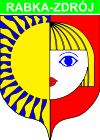Rabka-Zdrój
- "Rabka" redirects here. "Rąbka", on the Baltic coast, is a district of Łeba.
| Rabka-Zdrój | |||
|---|---|---|---|
|
Typical wooden house | |||
| |||
 Rabka-Zdrój | |||
| Coordinates: 49°36′30″N 19°58′0″E / 49.60833°N 19.96667°ECoordinates: 49°36′30″N 19°58′0″E / 49.60833°N 19.96667°E | |||
| Country |
| ||
| Voivodeship | Lesser Poland | ||
| County | Nowy Targ | ||
| Gmina | Rabka-Zdrój | ||
| Area | |||
| • Total | 36.59 km2 (14.13 sq mi) | ||
| Highest elevation | 560 m (1,840 ft) | ||
| Lowest elevation | 500 m (1,600 ft) | ||
| Population (2006) | |||
| • Total | 13,052 | ||
| • Density | 360/km2 (920/sq mi) | ||
| Postal code | 34-700 | ||
| Website |
www | ||
Rabka-Zdrój [ˈrapka ˈzdrui̯], usually referred to as Rabka, is a spa town in Lesser Poland Voivodeship, Poland. It is located between Kraków and Zakopane in a valley on the northern slopes of the Gorce Mountains, where the rivers Poniczanka and Słonka join the river Raba (49°36′30″N 19°58′0″E / 49.60833°N 19.96667°E). In 2008 it had a population of 13,052. There is a substantial population of Gorals in the town.
Rabka was always known for its salt-works, and from 1864 became a popular spa town. The first treatment centre for children was established a few years later and continues to this day. Hydrotherapy continues to be utilised in local hospital and sanatoriums. During World War II, the Germans established a Nazi police school in the town,[1][2] to train executioners and torturers. The school and its surroundings were the place of a series of atrocities before it was eventually closed down as the war approached its end and the Germans left.[3]
The Władysław Orkan Museum established in a former 17th-century larch-wood church, includes a collection of folk sculpture and paintings on glass. It also houses the "Order of the Smile Museum" (which children award to adults) and hosts events such as a winter carnival, the Carpathian Festival of Children's Regional Ensembles and the Mountain Children's Holiday International Festival. Other entertainment and folk events are held in the summer season. There is an open-air railway museum nearby in Chabówka.
Rabka-Zdrój sister cities are Rovaniemi, Finland; Murrhardt, Germany; Chateau-Gontier, France; Frome, England; Kiskunfélegyháza, Hungary and Gmina Dominowo.
 A park in Rabka-Zdrój
A park in Rabka-Zdrój Statue of Saint Nicholas, patron saint of Rabka
Statue of Saint Nicholas, patron saint of Rabka
Notable individuals
- Maria Kaczyńska, married to Lech Kaczyński (former President of Poland), was educated in Rabka.
References
- ↑ Michał Rapta , Wojciech Tupta , Grzegorz Moskal. Mroczne Sekrety willi "Tereska": 1939-1945. Grafikon, 2008 (in Polish). ISBN 8360817146.
- ↑ Grzegorz Rossoliński-Liebe. Debating, obfuscating and disciplining the Holocaust: post-Soviet historical discourses on the OUN–UPA and other nationalist movements. East European Jewish Affairs. Vol. 42, Iss. 3, 2012
- ↑ Robin O'Neil. The Rabka Four - A Warning from History. Spiderwize, Office 404; Albany House 324/326 Regent Street, London, W1B 3HH, UK. 2011.
External links
![]() Media related to Rabka-Zdrój at Wikimedia Commons
Media related to Rabka-Zdrój at Wikimedia Commons
- (Polish) Official website
- (Polish) Rabka-Zdrój
- Interactive Map
- Jewish Community in Rabka-Zdrój on Virtual Shtetl
- On-line version of the book Mroczne Sekrety willi "Tereska": 1939-1945 by Rapta, Tupta, and Moskal (2009 edition). (Polish)
- On-line version of the book The Rabka Four by O'Neil


